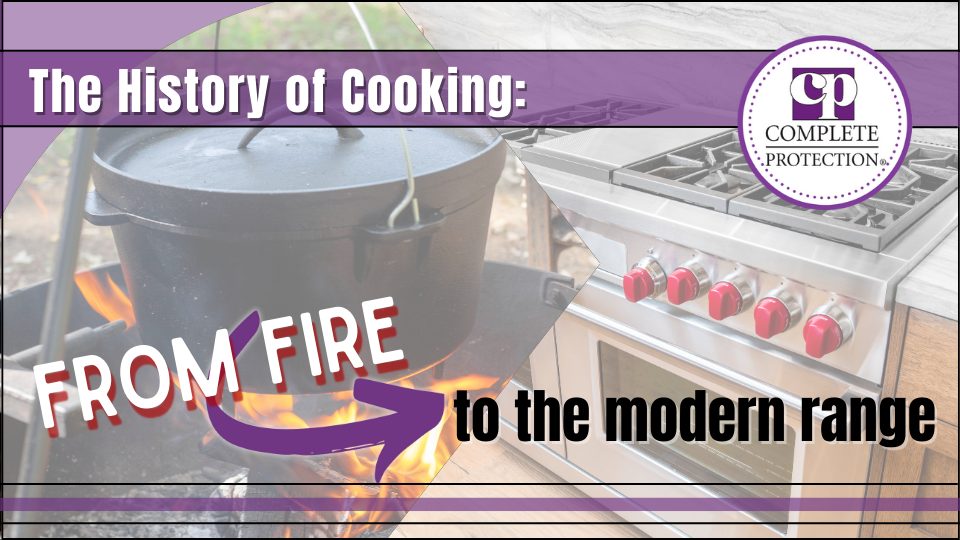The History of Cooking: From Fire to the Modern Range
November 15, 2024 by: Mandy Z.

The history of cooking can be traced back as far as humans have existed. It has been a central part of our evolution, transforming how we eat, live, and even think about food. From the first sparks of fire to the precision of modern ovens, the process has changed significantly over time. Let's explore the evolution of how we got to where we are today.
1. The Discovery of Fire
The history of cooking with heat begins with the control of fire, around 1 to 1.5 million years ago. When humans discovered that fire could be used not only for warmth and protection but also for preparing food our diets were fundamentally changed. Cooking with fire not only offered more nutrition, but also allowed early humans to preserve food. This simple act of cooking over an open fire became the cornerstone of human culture and community, as people gathered around fires to eat and share stories. As societies transitioned from nomadic lifestyles to settled agricultural communities, cooking methods became more sophisticated.
2. Clay Ovens
The concept of the oven as a dedicated cooking chamber began to take shape in ancient civilizations, particularly as humans began to settle and develop agriculture. The first structures that could be considered primitive ovens were large pits lined with stones where animal meat was wrapped in leaves to be cooked. Ancient Egyptians built dome-shaped ovens using clay and straw, featuring a fire chamber at the bottom for heat. The ancient Greeks and Romans developed clay ovens which were heated with wood or coal. Simple clay oven structures allowed for better control of heat, enabling people to bake bread, cook grains, and roast meat more efficiently. The ability to bake bread, a staple food in these societies, marked a significant advancement in the use of heat for cooking. These early ovens laid the groundwork for later developments in controlled cooking, even if they lacked the precision and control of modern ovens.
3. Cast-Iron Ovens and Hearths
Cast-iron ovens, which were more durable and heat-efficient, began to appear in the 16th and 17th centuries. These ovens were still fueled by wood, but their more solid construction allowed for better heat retention, enabling more consistent baking. Ovens were often constructed alongside homes or within hearths, large, central fireplaces, where families could bake bread and roast meats. This method of cooking with heat required a combination of skill and patience, as temperature control was achieved through adjusting the position of pots and managing the size of the fire. Despite their limitations, these ovens provided a reliable way to cook food in a new and challenging environment.
4. The First Stoves
The invention of stoves in the 18th century marked a turning point in the history of heat for cooking. Early stoves like the Castrol stove (invented by Benjamin Thompson, also known as Count Rumford) introduced the concept of more controlled and efficient cooking. These stoves used enclosed spaces to focus heat, significantly reducing the amount of fuel needed. The introduction of cast iron stoves in the 19th century further revolutionized cooking. These stoves had multiple burners and ovens, allowing for a variety of dishes to be prepared simultaneously. They also provided more precise temperature control, which led to the development of new cooking techniques like baking and simmering.
5. The Kitchen Range Revolution
The 18th and 19th centuries brought transformative changes to oven technology: gas and electric stoves. The gas oven allowed for a more controlled and even heat compared to traditional wood-fired models. Gas ovens were more efficient, could be turned on and off quickly, and required less manual effort for fueling and tending. Electric stoves followed, offering a safer and cleaner alternative to open flames. They also allowed for the development of new features, such as built-in thermostats, timers, and temperature control knobs, which made baking more consistent and reliable. The famous "kitchen range" combined a stove with an oven, allowing households to boil, fry, and bake using the same heat source. Ranges dominated kitchens well into the early 20th century, transforming how food was prepared at home.
6. Smart Ovens and the Future of Cooking
Today, ovens have become more advanced than ever before, with smart technology making its way into the kitchen. Smart ovens can be controlled via smartphone apps, offer precise cooking programs, and even include features like steam cooking and air frying. Brands like Samsung, LG, and others have developed smart ovens with touchscreens, voice controls, and Wi-Fi connectivity, offering unparalleled convenience and control. Induction ovens, which use electromagnetic fields to directly heat cooking vessels, have also gained popularity. These ovens are known for their energy efficiency and precise temperature control, making them a favorite among modern chefs and eco-conscious consumers.
Conclusion: A Journey of Adaptation and Innovation
The history of heat in cooking is a testament to human innovation and the desire to improve the way we prepare and enjoy food. The history of the oven is a testament to human creativity and the enduring importance of food in our daily lives. From ancient clay ovens and communal hearths to the high-tech appliances of today, the evolution of the oven reflects our ongoing desire to make cooking easier, more efficient, and more delicious. As we continue to innovate and adapt, the oven will remain a central feature of the kitchen, connecting us to the rich culinary traditions of the past while embracing the possibilities of the future.
